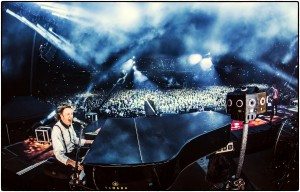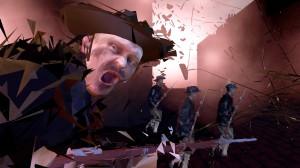
After more than 40 years of operation, DTVE is closing its doors and our website will no longer be updated daily. Thank you for all of your support.
The rise of VR and what it means for the TV industry
Virtual Reality is tipped to become a big business in the coming years. But how much potential does this technology hold for TV companies and to what extent should they be investing in this space? Andy McDonald reports.
The Virtual Reality sector is predicted to balloon in the coming years as new headset technology, games and content all hit the market. Today, VR enthusiasts already have a number of options ranging from HTC’s high-end, PC-tethered Vive headset, to Samsung’s Galaxy smartphone-compatible Gear VR, and Facebook’s Oculus Rift headsets which launch in Europe in September. However, the October launch of Sony’s PlayStation VR headset, which is designed to plug into PS4 consoles, and the autumn release of Google Daydream – a mobile VR platform that encompasses smartphones, a reference design for a headset and controller, and apps – means that by Christmas VR technology will be in more people’s hands than ever before.
Analysts clearly believe in the momentum behind VR – both 360° video and ’true VR’, which is typically computer rendered. Research firm IDC predicted earlier this year that worldwide shipments of virtual reality (VR) hardware will “skyrocket” in 2016, reaching 9.6 million units and revenues of US$2.3 billion (€2.1 billion). A Diffusion Group study from January claims that by 2025 VR will have a global user base of more than 275 million people and Futuresource Consulting predicts that total global spend on VR video and games content will reach US$8.3 billion by 2020. Meanwhile, Cisco’s most recent Visual Networking Index says that VR web traffic will increase 61-fold by 2020.
For those that have tried the technology, VR has a profound ability to place people into alternative realities and to offer new experiences and perspectives. But will this new category of entertainment be a be a significant application for broadcasters and TV service providers, and if so, how should they be preparing themselves for this?
Broadcasters get on board
Jaunt is a California-based specialist in cinematic VR – immersive, 360°, stereo video experiences – that has already won the support of the traditional TV space. The company, which raised US$65 million in funding last September, is backed by a number of high profile investors, including Sky, Disney and ProSiebenSat.1. “What’s great about what Jaunt does is we have an end-to-end solution for both creating, capturing, rendering and then distributing 360 VR content,” explains chief business officer, David Anderman. “We also have a studio that helps kickstart the creation of content that goes into our library in addition to working with partners, big media companies like ABC News and film studios.”
Before Jaunt, Anderman spent 16 years at Lucas Film where he served latterly as chief operating officer and general counsel before helping to sell the company to Disney in 2012. “One thing I loved about being at Lucas Film was George Lucas was just incredibly interested in this intersection between media and technology,” he says. “Jaunt has that in its DNA in the sense of taking this incredible technology that allows you to capture and distribute this content, but using that not as an end in and of itself but as a means to create these incredible experiences for consumers worldwide.”
Anderman believes that VR is “the first entertainment medium that is native to smartphones” and claims that broadcasters, operators and content makers are already seeing the tremendous potential in VR as a platform. While there are a range of VR headset options, he claims that smartphones twinned with headsets are an inexpensive entry point for VR that will drive adoption to a much broader audience.
“It’s a way to reach consumers worldwide,” he says. “It’s an IMAX-like experience, right in your pocket. There are a lot of companies – media companies in particular – looking to have a stake in this growing VR landscape. As a result, Jaunt continually gets inbound requests for investment. We’re already among the most well-financed VR and AR companies, which gives us a huge advantage [but] we can certainly use additional capital to scale the growth of the company very quickly and expand.”
In Europe, broadcasters like Arte have been among among the first to experiment with VR. The French cultural broadcaster released its first immersive cross-media doc series, Polar Sea, way back in November 2014 and in January this year launched a dedicated Arte360 app. The BBC is another early mover in this space. In June the UK public broadcaster unveiled its first “true VR” pieces of content, marking a distinction with the several pieces of 360° content that the BBC has previously published. Each of the new projects was designed to address challenges that would provide “invaluable insights for the organisation now and in the future,” the BBC said at the time.
One of these projects was Home – A VR Spacewalk, a collaboration between BBC Science, BBC Learning, BBC Digital Storytelling and VR studio Rewind VR, which was built for the HTC Vive VR headset and is due out later this year. Discussing the development, Rewind VR founder and CEO, Sol Rogers said the aim of the project was to “really push the boundaries and create real-time game engine-driven virtual reality”.
Home is essentially a short film, not a game, though Rogers says that the story gives the sense of freedom – “the illusion that you are there and you are crafting your own story” – which is helped by the use of the Vive’s hand gesture controls. “We’ve put these key
narrative beats though the story,” says Rogers, explaining that while users are free to roam the virtual space centre, some areas are inaccessible and cues from mission control are designed to keep users on track. “It’s kind of like putting the bumpers up on bowling. You throw the ball down there and it will always go down and hit the pins at the end, but however you throw it is up to you.”
Rogers claims that in a broad sense, many of the early VR projects being trialled by broadcasters and operators are essentially marketing exercises that can be used to show off first-mover credentials and to generate headlines. However, he claims that Rewind VR will only take on projects where the content is “very good” and will turn down work if it does not meet its standards. “Basically because we aren’t owned or invested by anyone externally, we’re only as good as the last project,” he says. At such a formative time in the industry, the quality of work being made today will also arguably have a very real impact on whether consumers embrace VR and opt to invest in VR headsets.
Defining experience
For Rogers, the PlayStation VR launch will play an important role in the uptake of virtual reality, with an existing installed base of more than 40 million PS4 consoles and a pre-Christmas release date likely to drive healthy sales of the headset. Indeed, speaking at the recent Edinburgh Digital Entertainment Festival, Simon Benson, director at the immersive technology group within Sony Interactive Entertainment Worldwide Studios said that PlayStation VR had been designed for a “really broad audience” and that for £349 (€409) in the UK and US$399 in the US, it has a “very low price-point when you compare it to any other option in high-end virtual reality systems.”
Sony will play to its strengths by focusing on games for the launch of its forthcoming PlayStation VR system. However, in Edinburgh Benson did also demonstrate a number of non-gaming applications for the new headset, including a 3D concert recital that puts users at the centre of the performance, and a forthcoming PlayStation title called VR Worlds that includes one experience that does not have any traditional “game mechanics”.
“You’ve not got an objective, you’re not trying to score anything or achieve anything – you’re just experiencing it,” said Benson, describing ‘Ocean Descent’, an underwater diving cage in shark-infested waters, which is one of five virtual reality experiences included in VR Worlds. He described this type of ‘virtual tourism’ as “a really interesting area” that has the potential to reach a wide audience and bridge the gap between what does and doesn’t count as a “gaming experience”. He also said that games developers were starting to explore ‘tourist modes’ within games – to allow players to pause from the action and take in impressive virtual vistas.
The kinds of experiences described by Benson pose fundamental questions about the kinds of content that will start to emerge in the age of virtual reality, and about the dividing lines between what games companies or entertainment specialists that should be looking to create.
Mark Harrison, director of transformation, design and engineering, at the BBC, says that while he believes that immersive technology – namely VR, AR and 360° video – will prove “extremely important culturally”, they will not necessarily be extremely important for television. “In my view, there is no broadcaster that has to invest in VR or 360° at the moment. The desire to innovate is so baked into the media industry that as soon as we encounter some new form of media or new way of communicating with an audience, we instinctively feel that it must be important for us and we must engage in it.”
Harrison says that that there is huge potential around gaming, but after that, the media type best suited to VR is ‘experience’. This is a category that he can see being very strong in brand experiences, marketing in retail and other areas such as training, education, health and “in some aspects of some of the things that TV does”.
“What TV is very best at is storytelling. When you really get down to the details of what immersive technologies are best at, they’re not best at storytelling – certainly not at long-form storytelling,” claims Harrison. He believes that the rise of immersive, VR content will not necessarily be to the detriment of television – at least not for a very long time.
“I partly base that on our current capacity as human beings to keep on adding media forms to our consumption behaviours rather than them being substitutional. The ultimate example of that is the rise of gaming,” he says. “I have a hunch that where we’ll see immersive tech provide very strong experiences will actually be in different consumption contexts. So by that I mean increasingly if we are buying a holiday or we are buying a house or we are looking to buy a new car, we will find ourselves being offered a VR or AR or 360 experience.”
Nordic broadcaster Modern Times Group (MTG) is one of a number of television players currently figuring out where to navigate next in the VR space. Like NBC in the US and the BBC in the UK, MTG recently teamed up with Samsung to make VR Olympics coverage available on Gear VR headsets. MTG made approximately 100 hours of content available through the Viasat Sport 360 app, using the Games as an important learning opportunity. “We believe that for these kinds of technologies it’s a perfect moment to collect user data, look into behavioural patterns and understand what are the key benefits and challenges with Virtual Reality in general,” says Bartek Gudowski, chief technology officer at MTG Broadcasting.
Post-Olympics, Gudowski says that MTG aims to understand how to build a narrative and about different types of products and storytelling in VR. “I think our initial first stab is going to be to try to extend existing productions with virtual reality,” he says, discussing ways to enhance content outside of just purely sports broadcasts.
“I believe it’s primarily [about] experimenting with existing productions and adding on new experiences and trying to find the killer experience before we start with new productions of virtual reality – which is a very costful exercise,” says Gudowski. “One very interesting thing for us in general is that our Ultra HD initiatives are going quite in hand with virtual reality, because they all require the same enhancements in terms of the camera technologies, the distribution networks and the resolution on the screens. So there are great synergies long-term with these two technologies and how they actually [help to] develop each other in the right direction.”
Content strategies
Mark Atkin is director of Crossover Labs, an international training organisation dedicated to developing cross-media content and exploring challenges related to developing digital media. Crossover also recently worked on a VR project for the BBC called Easter Rising: Voice of a Rebel alongside BBC R&D, BBC Learning and VR specialists VRTOV – producing a “new form of history documentary” that uses VR to present historical events from the perspective of those involved.
Atkin, who previously held a multi-platform commissioner role at Channel 4, believes that VR is a good medium for documentary and the type of drama where the viewer can actually be on stage, interacting with the characters. He says some news would also be interesting – “breaking news where there’s some value in being able to see all around you; things like the recent primaries in America.” However, he is not convinced that sports, a category of content that is already designed for television would benefit. “You’ve got to think how does the experience in VR become enhanced? If all you’re doing is just sitting in a crowd, I can’t see the point of that.”
MTG’s Gudowski says that for sports, such as boxing, VR works “very well because you can actually get very close to the action”. However, he concedes that that for some other sports, where you can’t be close to the action, the viewer does not get the feeling of presence that they would necessarily expect. “Close up action, with a high degree of presence, makes [for] virtual reality in its perfect form.”
Jaunt’s Anderman says that a lot of the early VR experiences that have appealed to consumers are focused on travel and adventure, storytelling, sports and music. With the recent launch of Juant’s publishing programme, which allows VR creators to publish their content directly to the Jaunt VR app, Anderman says “the content that we are accepting is fitting those criteria”.
In terms of Jaunt’s own production output from its two year-old Jaunt Studios division, Anderman names a live Paul McCartney concert film, one of Jaunt’s first VR experiences, as one of its most successful to date. Meanwhile, he also claims that news content tends to be very popular in the short-term, but then “falls off as that topic tends to fade away from the news”. An example of this is was an ABC News-produced VR piece on North Korea, which Anderman says got an incredible reaction in the first 48 hours with 17 million 360° video views on Facebook alone, before traffic tailed off. However traffic did rise again months later when North Korea was back on the news agenda.
Rewind VR has done work in the past for brands such as Red Bull, Nissan and singer Bjork, and founder Rogers agrees that certain close up sports – like basketball and tennis – and music or concert footage have a lot potential in VR. However he says that the biggest area will be around “VR vignettes” – secondary stories or spin-offs around popular stories or characters. “VR can let me be in Harry Potter and let me do a wizard’s duel,” Rogers says by way of an example.
Looking ahead, Rogers believes that the VR space will grow “very rapidly” for those with stakes in the entertainment business. “It’s not going to be a bubble that bursts, but there’s definitely going to be a good cooling off period when some of the people who aren’t making the good stuff, who are calling themselves VR specialists, get found out,” he predicts.
At the BBC, Harrison is not quite so convinced that VR will be a big part of the broadcaster’s plans any time soon. While he sees the potential for more 360° video, he says that for “full-blown VR” it is probably more suitable for the BBC to provide input rather than try and build those experiences itself. “I’m sure that we will go on experimenting in this area but I wouldn’t see it becoming part of our mainstream output for a while yet. There are still so many questions that need to be resolved and there’s so much that needs to mature in this area,” he says.
For others working in this space, the future is clear, and it can be glimpsed through the immersive lens of a VR headset. “I really do think that the current generation of toddlers probably will never ever turn on the television,” says Crossover Labs’ Atkin. “These are the ones who will be growing up in adulthood in the post television screen world – they won’t need that in the house anymore. We all need to prepare for that: the creative community and the broadcasters alike.”
Jaunt’s Anderman agrees, claiming that the “smart players” in media don’t want to miss another paradigm shift, with recent history providing plenty of reminders about the need to keep up with digital trends. “The folks that waited to make the shift to digital-only music and stubbornly held on to physical distribution models literally got killed – they’re no longer in business,” he says. “I think in this day and age and across all media and entertainment those that fail to embrace these new trends in how content is consumed will die. I think no media company is going to take that risk.”





